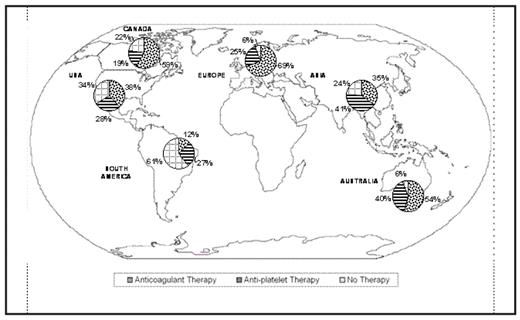Abstract
Background: In pediatric arterial ischemic stroke (AIS) clinical treatment trials are lacking and treatment practices variable. Factors determining treatment selection and outcomes are important to delineate.
Objective: We aimed to (1) describe acute treatments and outcomes in childhood AIS, and (2) test putative variables for treatment selection, and outcome in a prospective-retrospective multicenter international study.
Methods: We evaluated treatments and early outcomes of children enrolled in the International Pediatric Stroke Study with AIS diagnosed at >28 days and <18 years of age from 2003 to 2007. Putative predictor variables for antithrombotic treatment selection included age, clinical AIS subtypes, geographic region (Asia, Australia, Canada, Europe, South America, and U.S.), and diagnosis pre- versus post-2004 (when pediatric AIS guidelines published).
Results: Among 676 children with acute AIS, anticonvulsants and antibiotics were administered acutely in 57% and 40%, respectively; use of each decreased with age (P<0.001). Acute anticoagulants (AAC; with/without concomitant anti-platelet therapy) were selected more frequently than either acute anti-platelet agents (AAP) alone or no acute antithrombotic treatment (NAAT) (43% AAC vs. 28% AAP alone and 29% NAAT). NAAT decreased with increasing age. AAC was most frequent in cerebral/cervical arterial dissection (n=52; 75% AAC vs. 6% AAP) and least frequent with moyamoya syndrome (n=72; 31% AC vs. 43% AAP). AAC was most common in Europe and Canada, AAC vs. AAP relatively balanced in the U.S., and AAP most common in Asia and South America. AAC use was similar pre- versus post-2004. At hospital discharge 71% had neurological deficits independent of age, subtype, or geographical region. Mortality at discharge was 3%.
Conclusions: Acute anticoagulation is frequently but not uniformly employed in childhood AIS. With current treatment, the prevalence of neurological deficit at hospital discharge is high. These findings reflect disparity in published guidelines and highlight the need for clinical trials to reduce adverse outcomes.
Acute antithrombotic therapy in childhood AIS, by geographic region.
Disclosures: Off Label Use: Reference will be made to anticoagulants in general as an antithrombotic treatment approach in pediatric arterial ischemic stroke, without emphasis upon specific treatment agents. All anticoagulants are used off-label in children with arterial ischemic stroke.
Author notes
Corresponding author


